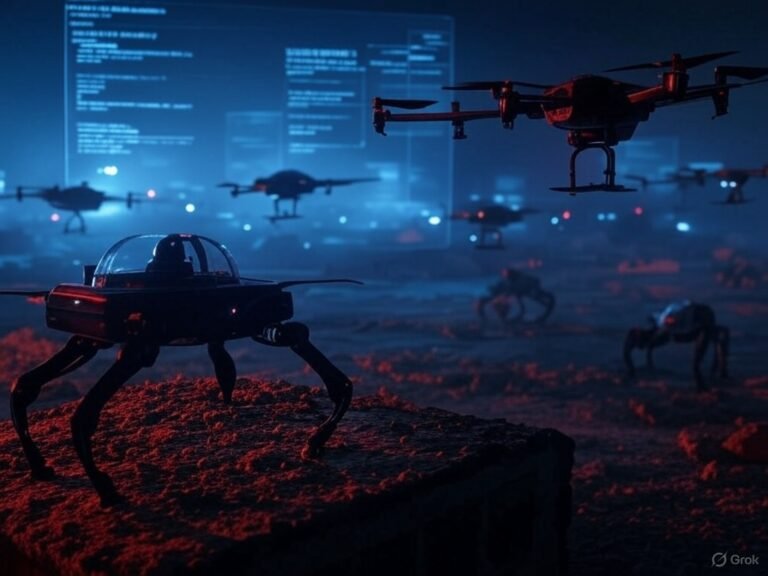
1. Introduction — Private Industry Is Building the Battlefield
Nation-states may declare wars, but in the age of artificial intelligence and automated warfare, autonomous weapons companies are the ones building the battlefield.
The past decade has seen a dramatic shift in how militaries develop, deploy, and control force. While governments still authorize strikes, the software and systems deciding when, how, and what to target are increasingly designed by private defense-tech firms. These companies are not just building drones—they’re writing the algorithms that interpret sensor data, predict movement patterns, and even propose lethal action.
From loitering munitions and drone swarms to battlefield decision platforms like Project Maven, the future of warfare is being shaped in startups, defense labs, and AI platforms—many of which operate with minimal transparency or legal oversight.
This article profiles 10 autonomous weapons companies that are transforming military power as we know it. Some build killer drones. Others develop AI software that fuses intelligence in real time. But all of them are helping define the next era of armed conflict—where decision-making may no longer be fully human.
2. What Defines an Autonomous Weapons Company?
As militaries race to adopt next-generation technologies, the term “autonomous weapons companies” is no longer limited to traditional defense contractors. A new class of firms—blending software, robotics, and battlefield AI—is emerging to build, train, and deploy systems that can act with minimal or no human input.
But what actually qualifies a company as part of this category?
At its core, an autonomous weapons company develops systems capable of selecting, tracking, or engaging targets without direct human control. This includes:
- Hardware manufacturers building loitering munitions, swarming drones, or robotic systems with onboard AI
- Software developers creating targeting algorithms, battlefield decision platforms, or AI kill-chain enablers
- Full-stack defense tech firms offering end-to-end autonomy—from detection to strike recommendation or execution
Some firms focus on real-time ISR (intelligence, surveillance, reconnaissance) that feeds autonomous decision-making loops. Others build command-and-control AI systems that fuse battlefield data across sensors, assets, and domains.
What unites them is a shift in how war is mediated through technology. These companies don’t just provide tools; they provide decision logic—a software layer that sits between operator and outcome.
As international law struggles to catch up, these autonomous weapons companies are defining the next strategic frontier, often faster than governments can regulate or even fully understand.
3. The 10 Companies to Watch
These firms are at the cutting edge of battlefield autonomy—blending software, robotics, and AI to change how wars are fought. Whether through loitering munitions, drone swarms, or real-time targeting systems, these autonomous weapons companies are shaping the global arms race.
1. Anduril Industries ( United States)
Founded by Palmer Luckey, Anduril is known for fusing Silicon Valley software speed with defense hardware. Its flagship products include the Ghost 4 drone, autonomous sentry towers, and the Lattice OS—an AI command-and-control platform capable of integrating sensor data, tracking threats, and proposing engagements. With deep DARPA ties and contracts across U.S. Special Operations, Anduril is building kill-chain compression tools that put autonomy at the center of future operations.
2. Palantir Technologies (United States)
Palantir doesn’t build weapons—it builds the software that decides how they’re used. Known for its roles in Project Maven, Gotham, and Foundry, Palantir has embedded itself in the heart of modern battlefield intelligence. Its systems integrate drone feeds, satellite imagery, and sensor data to identify and prioritize threats in real time. As a leading player among autonomous weapons companies, Palantir raises pressing ethical concerns about transparency and algorithmic accountability.
3. STM (Savunma Teknolojileri Mühendislik) (Turkey)
STM is the developer of the Kargu-2 loitering munition, which gained international attention after a UN report suggested it may have autonomously engaged humans in Libya in 2020. The company specializes in swarm tactics and urban combat deployment, with ongoing R&D in distributed drone logic and human-out-of-the-loop targeting. STM represents the tactical, export-focused face of battlefield autonomy.
4. Elbit Systems (Israel)
Elbit Systems is a leading force in AI-integrated weapons, best known for the LANIUS microdrone—a lethal indoor loitering system capable of autonomous navigation and threat identification. Alongside its HERO loitering munitions, Elbit pushes the edge of autonomous lethality in urban and asymmetric warfare. Its systems are increasingly designed for man-on-the-loop control, giving operators the ability to intervene—but not necessarily to direct. Elbit’s place among autonomous weapons companies stems from its dual role in offensive capabilities and AI-enhanced ISR across highly sensitive environments.
5. Baykar Technologies (Turkey)
Best known for its Bayraktar TB2 drones, Baykar has risen to prominence through real-world deployments in Ukraine, Syria, and Libya. Now developing the TB3 and Kızılelma jet-powered UCAVs, Baykar is integrating onboard AI systems for route planning, object recognition, and semi-autonomous strike capability. Its systems are gradually shifting from remote-controlled to machine-assisted targeting, pushing the boundaries of human-machine combat roles. Baykar’s evolution puts it firmly on the radar of global autonomous weapons companies reshaping mid-tier drone warfare.
6. Kratos Defense & Security Solutions (United States)
Kratos is at the forefront of autonomous combat aircraft, particularly the XQ-58A Valkyrie—a stealthy, AI-enabled “loyal wingman” drone designed to fly alongside manned jets. With contracts from the U.S. Air Force and DARPA, Kratos is developing swarm logic, autonomous teaming behaviors, and air-to-air capability for unmanned systems. As nations race to operationalize autonomous dogfighting, Kratos represents the tip of the spear among aerospace-focused autonomous weapons companies.
7. Ziyan UAV (China)
Ziyan UAV is one of China’s most visible players in autonomous aerial systems. Its Blowfish A3 is a rotary-wing drone capable of autonomous flight, target tracking, and lethal engagement, with reported deployments in PLA naval exercises. Ziyan focuses on swarm-enabled aerial strike capabilities, including group decision-making algorithms and formation control. As part of China’s broader push for “intelligentized warfare,” Ziyan exemplifies how autonomous weapons companies are blurring the lines between surveillance and preemptive strike capacity.
8. EDGE Group / HALCON (United Arab Emirates)
Backed by the UAE government, EDGE Group—through its subsidiary HALCON—is rapidly positioning itself as a global hub for export-ready autonomous weapons. Its Hunter 2-S drone system features autonomous swarm coordination for area denial and saturation attacks. EDGE integrates indigenous design with AI and sensor fusion, offering affordable yet scalable AWS options to non-NATO clients. Among emerging-market autonomous weapons companies, EDGE is notable for combining sovereign ambition with private-sector agility.
9. UVision Air (Israel)
UVision develops the HERO series of loitering munitions, including systems capable of man-in-the-loop and AI-guided strike modes. These drones are in use with multiple NATO militaries and offer modular payloads for varied mission profiles. With real-time object recognition and target prioritization software, UVision straddles the line between precision weaponry and tactical autonomy. Its growing presence in allied procurement makes it a key player in autonomous weapons companies enabling fast-response battlefield lethality.
10. Helsing AI (UK/Germany)
Helsing isn’t building drones—it’s building the AI layer that tells them what to do. This defense-tech startup focuses on real-time sensor fusion, object recognition, and decision support systems for NATO-aligned forces. It recently partnered with Saab and secured major European contracts to enhance battlefield situational awareness. As one of the few software-only autonomous weapons companies, Helsing shows that the future of lethal autonomy doesn’t always come with wings—it can arrive in a battlefield OS.
4. Why This Matters — A New Industrial Military Complex
The rise of autonomous weapons companies signals a profound shift in how military power is designed, deployed, and distributed. These firms are not just contractors—they’re strategic actors in their own right, with direct influence over the tools, algorithms, and ethical boundaries of modern warfare.
Like the Cold War’s defense giants—Lockheed, Raytheon, Northrop—today’s AI-focused defense startups are shaping doctrine as much as hardware. But unlike their predecessors, many of these new players operate in hybrid legal zones: straddling civilian tech, dual-use platforms, and military application pipelines that often outpace regulation.
There are serious risks embedded in this new ecosystem:
- Privatized targeting logic: When AI systems recommend or carry out strikes, who owns the responsibility?
- Arms race dynamics: As one state adopts AWS, others rush to match or counter—often by outsourcing.
- Lack of transparency: Many platforms are classified, proprietary, or shielded from public oversight.
And yet, the demand is growing. Governments want faster kill chains. Militaries want machine-speed decisions. Private firms are answering with autonomous solutions that reduce human friction—and human accountability.
These autonomous weapons companies are building more than just systems. They’re shaping how decisions are made in war, and in doing so, they’re creating a new version of the military-industrial complex: one that runs on code, data, and algorithmic authority.
5. Conclusion — Who Owns the Kill Chain?
In today’s wars—and tomorrow’s—autonomous weapons companies are not just suppliers. They are coders of doctrine, architects of decision, and quiet partners in the projection of force.
As these firms grow more powerful and their systems more autonomous, fundamental questions arise:
Who writes the rules when software can select a target? Who is accountable when a machine makes a mistake?
These are no longer abstract hypotheticals. From Gaza to Donbas, Libya to the Pacific, autonomous and semi-autonomous systems are already shaping outcomes—and doing so under the brand names of private defense labs.




The work balances clarity and mystery. It offers guidance while preserving space for the reader’s own imagination and insight.